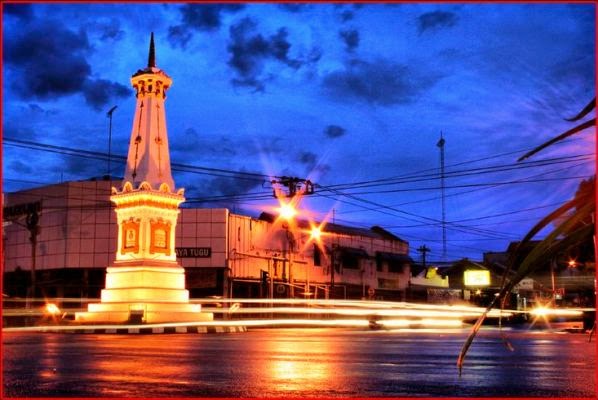TUGU JOGJA
The Most Popular Landmark in Yogyakarta
Tugu Jogja Tugu Jogja is one of the most popular landmark of Yogyakarta. The Tugu Jogja is almost 3 centuries old and has a very deep meaning and history about Yogyakarta. Tugu Jogja was built about a year after the formation of Ngayogyakarta Hadiningrat Kingdom. During the early time of the construction, it represented about the unity of God’s creature that means the spirit of togetherness of lay people and the authorities to fight against the colonial era of Dutch. Tugu Jogja collapsed after the big earthquake of 1867 and rebuilt by Dutch government in 1889 with completely different design. Tugu Jogja is located in the center of the crossroad between the Mangkubumi, Soedirman, A.M. Sangaji and Diponegoro street. The monument is constructed as a square base with each side decorated with a kind of inscription about everyone who involved in the renovation, written in Javanese alphabet with a gold paint. Tugu Jogja is also decorated with some artistic carvings of traditional Java. The top of the monument is a pointed cone form, it is completely different compared to its predecessor which has spherical-shaped top. The height of the monument is also lower, it is only 15 meters tall. Nowadays, the monument is surrounded by a small garden and fence. The presence of ornamental lamps at the bottom of the monument make it looks so pretty and exotic in the night. Because of this reason, it makes the monument as one of the most popular photography spot, mainly for the travelers.
Tugu Yogyakarta is a monument or a monument that is often used as a symbol or emblem of the city of Yogyakarta. This monument was built by Hamengkubuwana I, founder of the Yogyakarta palace. Monument is located at the intersection of Jalan Sudirman and Jl. This Mangkubumi prince, has symbolic value and is a magical line that connects the southern ocean, the palace of Yogyakarta and Mount Merapi. At the time of meditation, it is said the Sultan of Yogyakarta at the time to use this monument as a benchmark toward the mountain top overlooking Merapi.
This monument is now one of the tourism attractions of Yogyakarta, and is often known as the "pillar of white pal" (pal also means pillar), because of the color of paint used since the first is white. Pal monument is elliptical with a small ball and a sharp corner at the top. From Yogyakarta palace if we look to the north, then we will find that Jalan Malioboro, Jl Mangkubumi, this monument, and Yogya Kembali Monument Road will form a straight line exactly with the direction to the summit of Mount Merapi.
Tugu Jogja was built around one year after the construction of Yogyakarta Kingdom. At the early time of its construction, it clearly described the philosophy of the unity of God's creatures that means the spirit of togetherness of lay people and authorities to fight colonials. In Javanese term, the spirit of togetherness is called golong gilig that is clearly described in the construction of the monument: the pole is of gilig (cylinder) form and the top part is golong (rounded). This monument was known as Tugu Golong-Gilig.
In details, the monument was originally constructed in the form of a cylindrical pole with conical form upwards. The base is an encircling fence while the top is rounded. The preliminary height of the monument was 25 meters.
Everything changed when on Monday, 10 June 1867, a big earthquake in Yogyakarta ruined the monument. The collapse of the monument was the transition time when the unity was not really reflected on the monument.
The situation changed totally when in 1889 the Dutch government renovated the monument. The monument was constructed as a square with each side being decorated with a kind of inscription containing the names of people who were involved in the renovation. The top portion is no longer rounded but a pointed cone. The height of the monument is also lower, namely 15 meters. Since then, this monument was also called as De Witt Paal orTugu Pal Putih (white pole monument).
The renovation of the monument was actually the tactic used by the Dutch colonial to erase the philosophy of togetherness between lay people and the king. Learning from the result of the struggle afterwards, however, the effort did not seem to be successful.
If we want to look at the monument satisfactorily while remembering its philosophical meaning, there are benches facing the monument on the corner of Mangkubumi Street. At 05:00 a.m. - 06:00 a.m. is the right time since the air is still fresh and not much passerby yet. Occasionally, the newspaper boy will greet us politely while riding his bicycle to go to the distribution office of the biggest local newspaper, the Kedaulatan Rakyat.
Being so identical of the Tugu Jogja to Yogyakarta makes many university students from outside of Yogyakarta to express their happiness after the graduation day by hugging and kissing the Tugu Jogja. That may also express their love to Yogyakarta that they will about to leave soon and at the same time say their promise to return to this city.


.jpg)

No comments:
Post a Comment